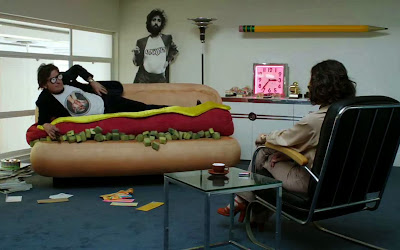Is it me or was Charlie Sheen an actor at one point? Because as far back as I can remember, Sheen has always been a guy who punched hookers and then appeared on a sitcom or in a bad parody movie to make fun of the fact that he punched hookers. 98% of this guy’s career has been one prolonged wink and it has never been funny or charming. He’s not an incorrigible rascal, he’s the kind of guy whose death will be ruled an apparent suicide because coke-fueled, auto-erotic asphyxiation is far too long to fit on a death certificate.
However, there was one slightly redeeming factor behind Sheen’s, ‘ain’t I a stinker’ routine and it’s the fact that he never tried to convince us that he was anything more than an enormous garbage idiot. He wasn’t a beautiful sensitive man who deserved love, he was a guy who joylessly mumbled out the word boner on TWO AND A HALF MEN. Unfortunately, A GLIMPSE INSIDE THE MIND OF CHARLES SWAN III changed all that because now we’re supposed to give a damn about the man behind the STDs and, unlike Emilio Estevez, that’s not a step I’m willing to take.
Loosely based around the graphic art of Charles White III, SWAN tells the story of a dying blood hound in sunglasses (it could be a hard-partyin’ graphic artist named Charles Swan III. With Sheen in the role it’s really difficult to say) whose girlfriend (Katheryn Winnick) breaks up with him and makes him very sad. So sad that he drives his vintage Cadillac into a pool, spends way too much money on caviar and throws a garbage can at a tall building. Eventually Sheen confronts Winnick about the break-up and tells her that he doesn’t want to never not love her (or something). Winnick then thanks him for all the experiences he gave her. Even the ones where he fucked other women behind her back. As they part ways, Sheen imagines himself singing an acoustic cover of "Aguas De Marco" with Winnick because stilted quirkiness equals genuine comedy. Sheen then goes to a party and feels better when he watches a marionette version of himself look up a woman’s dress. The End.
I know I’m in the minority here, but I find those elaborate, aggressively quirky, Etsy-ready products Wes Anderson calls movies completely insufferable. Additionally, I’ve always thought his comedies were for people who felt that laughter is something those grimy, dirt people do at Jeff Dunham concerts. But as much as I dislike Anderson, at least I can say that his movies are actually movies. At least they have a beginning, a middle and an end. At least his characters aren’t a series of vaguely defined traits awkwardly stuffed into a series of silly '70s inspired wigs. And that’s more than I can say about Roman Coppola who is basically everyone’s most negative opinions about Wes Anderson realized in one person.
Apart from the one-dimensional characters and the thin, practically non-existent storyline, CHARLES SWAN III fails because it’s trying to shoehorn Sheen’s eternally sleazy tabloid persona into the twee, artisanal sensibilities of a Wes Anderson film and it’s a combination that not only doesn’t work, it’s actually punishing to watch. It’s kind of like an issue of Maxim that’s been edited by Chris Ware or a movie based on the art of Henry Darger directed by Russ Meyer. Throughout the film there are numerous fantasy sequences where Sheen is murdered by shrewish women in stereotypical Native American drag or nearly murdered by the vindictive agents of the Secret Society of Ballbusters who are such totally, on the rag bitches they get all upset when their boyfriends try to pick up women behind their backs. Look, females! Understand that our penises just end up inside of things. Sometimes it’s a strange lady other times it’s a tepid bowl of Spaghetti-Os. Our penises are not a crime! Now get off the rag, get on the treadmill and go back to your stronghold on Bitch Mountain! Playful misogyny aside, CHARLES SWAN III makes no attempt to challenge or comment ironically on Swan’s sexist point of view. The film just shrugs its shoulders and happily agrees with him. CHARLES SWAN III is basically just a series of whimsical interpretations of a sexual predator’s self-loathing filled daydreams. Oh, and there’s also a scene with a hot dog couch, so look out for that.
Shockingly, apart from Sheen’s stuntcasting, CHARLES SWAN III boasts (and wastes) an amazing cast that includes Aubrey Plaza, Jason Schwartzman, Mary Elizabeth Winstead, Colleen Camp and Bill Murray. Yes, that Bill Murray. The same Bill Murray who’s extremely selective about everything he does and refuses to appear in things like COMMUNITY and PARKS AND RECREATION. What happened here? Was it a personal favor to Anderson? Did he pull another Garfield and wrongly assume this movie was directed by Francis Ford Coppola? Whatever the reason, he’s in it and he doesn’t look too happy about it. He just looks logy and beaten down. Maybe he pissed off Anderson and this was some kind of penance he had to perform before he could appear in MOONRISE KINGDOM.
Still, if I have to say something nice, I will say I enjoyed the Liam Hayes soundtrack. Everything else about this DVD can decay on the floor of that abandoned strip mall where Blockbuster Video used to be.
-- Mike Sullivan





















